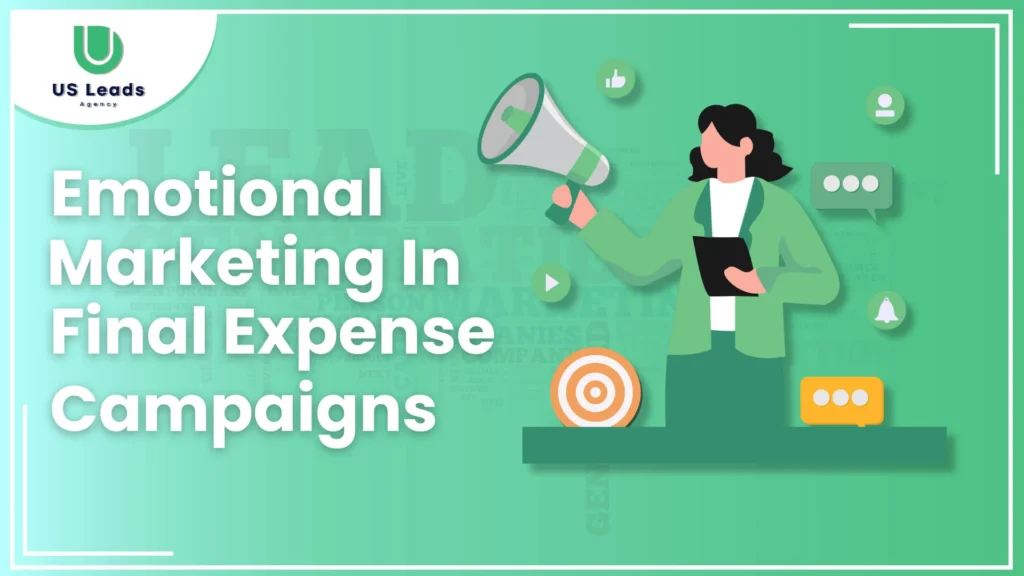
Final expense insurance represents more than a policy, it’s a promise of security and care for loved ones. Emotional marketing, which appeals to feelings and values instead of technical features, is a powerful strategy for connecting with prospective buyers and generating high-quality leads.
This article explores how to leverage emotional marketing in final expense leads to foster trust, inspire action, and drive conversions in final expense lead campaigns.
Key Takeaways:
- Emotional marketing is essential for connecting with final expense insurance buyers.
- Strategies include storytelling, empathetic messaging, and tailored campaigns.
- Visual content and targeted channels deepen emotional connections.
- Tracking engagement and conversions ensures campaign success.
Table of Contents
What Is Emotional Marketing?
Emotional marketing focuses on connecting with the audience’s feelings, values, and aspirations. In the context of final expense lead campaigns, it means acknowledging and addressing their concerns about family well-being and financial security.
Why It Works?
- Addresses Pain Points: Taps into fears of leaving financial burdens.
- Builds Trust: Humanizes the sales process through relatable stories.
- Encourages Action: Inspires urgency by emphasizing peace of mind.
Why Emotional Marketing Is Vital In Final Expense Campaigns?
- Addresses Core Concerns: Many buyers worry about the financial impact of their end-of-life expenses. Emotional marketing shows empathy for these fears and offers a reassuring solution.
- Creates Relatability: Stories of how others have benefited from final expense insurance help prospects envision themselves experiencing the same relief and security.
- Fosters Long-Term Connections: An emotional bond makes customers more likely to trust your brand and recommend it to others.
Strategies For Effective Use Of Emotional Marketing In Final Expense Leads:
1. Craft Compelling Stories:
- Use testimonials and real-life scenarios to highlight the impact of final expense insurance.
- Example: A story of a family relieved of financial stress after a loved one’s passing.
2. Focus on Empathetic Messaging:
- Use phrases like “Protect your loved ones” or “Leave a legacy of care.”
- Prioritize emotional benefits over policy details.
3. Leverage Visual Content:
- Use videos or images depicting families, heartfelt moments, or peaceful end-of-life scenarios.
- Visuals amplify emotional connections and engagement.
4. Tailor Campaigns To Demographics:
- Understand cultural values and family structures.
- Example: Highlighting legacy-building for communities where financial inheritance is important.
5. Use Empathy-Focused Channels:
- Utilize social media, direct mail, or personalized emails to create conversational connections.
- Platforms like Facebook enable targeted campaigns with a personal touch.
Examples of Emotional Marketing In Action:
- Personalized Emails: Begin with a warm tone, address recipients by name, and acknowledge their concerns.
- Storytelling Ads: Showcase real-life examples of how final expense insurance eased a family’s financial worries.
- Social Media Campaigns: Use platforms like Instagram or Facebook for testimonials, emotional videos, and infographics.
Measuring The Impact of Emotional Marketing In Final Expense Leads:
To ensure your campaigns resonate, track key metrics like:
- Engagement Rates: Likes, shares, and comments.
- Lead Conversions: New inquiries or policy sign-ups.
- Customer Feedback: Testimonials or survey responses.
Conclusion:
Emotional marketing is indispensable in final expense lead campaigns. It humanizes the sales process by addressing buyers’ concerns with empathy and storytelling. By leveraging targeted messaging and visual content, marketers can foster trust, inspire action, and ensure their policies provide the comfort and security buyers seek.
FAQs:
How can storytelling enhance final expense lead generation?
By showcasing real-life scenarios, storytelling highlights the emotional and practical value of these policies.
Which channels work best for emotional marketing in final expense campaigns?
Social media, personalized emails, and direct mail are effective for empathy-driven messaging.
How can marketers measure the success of emotional marketing strategies?
By analyzing engagement rates, lead conversions, and feedback.
